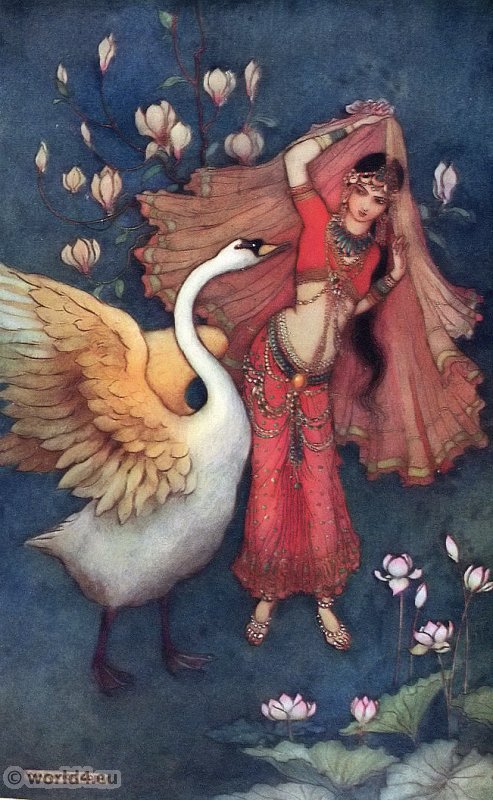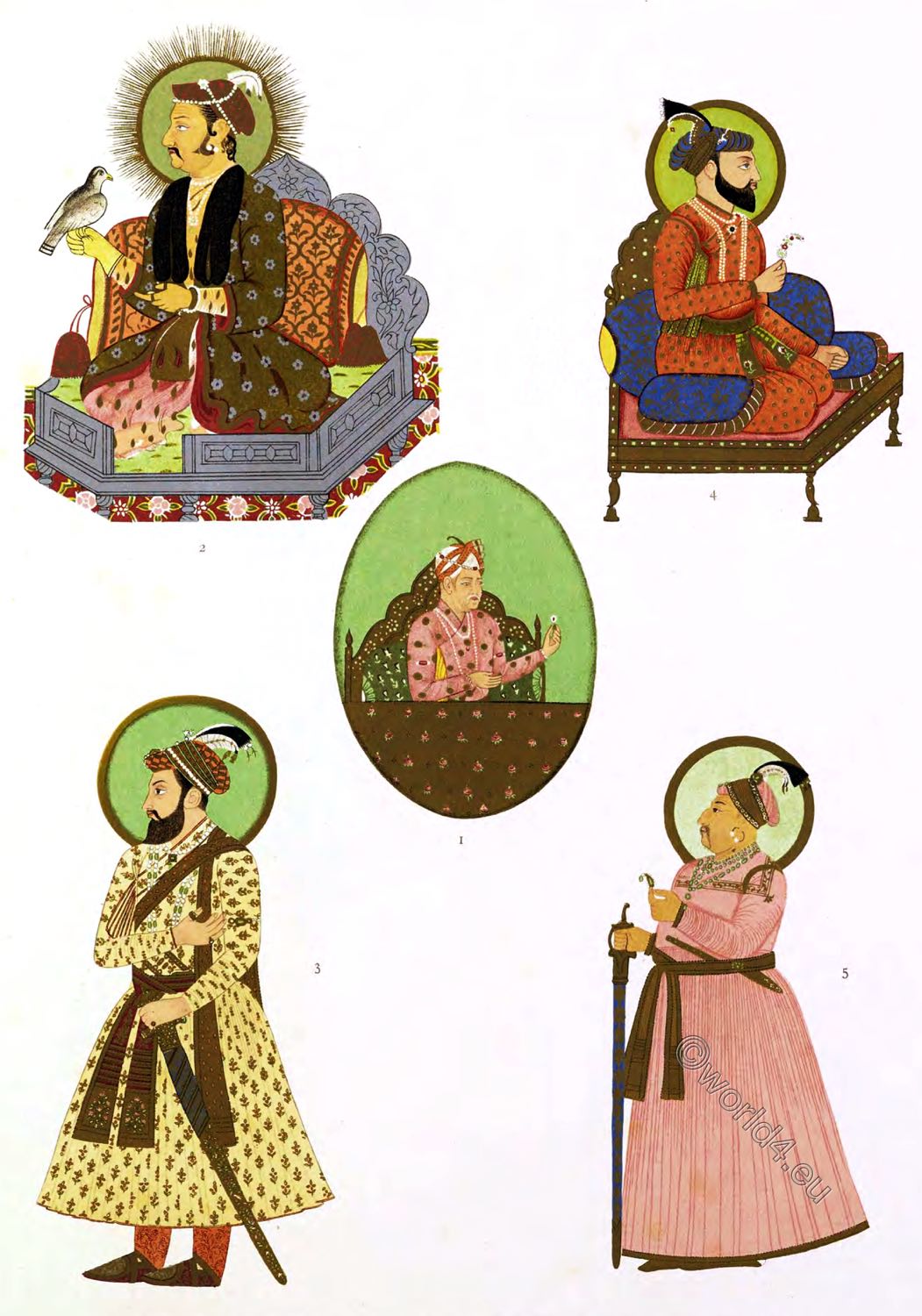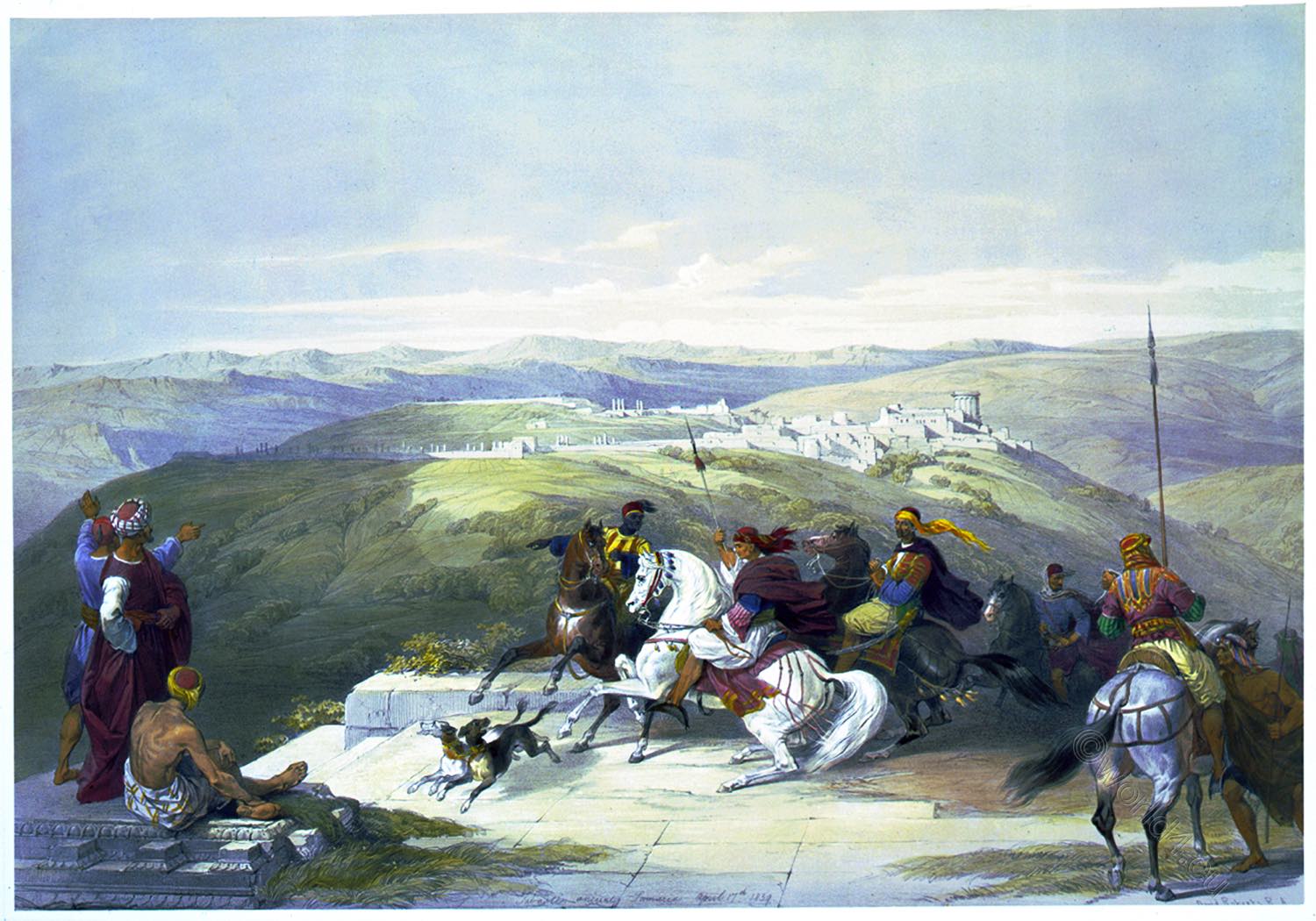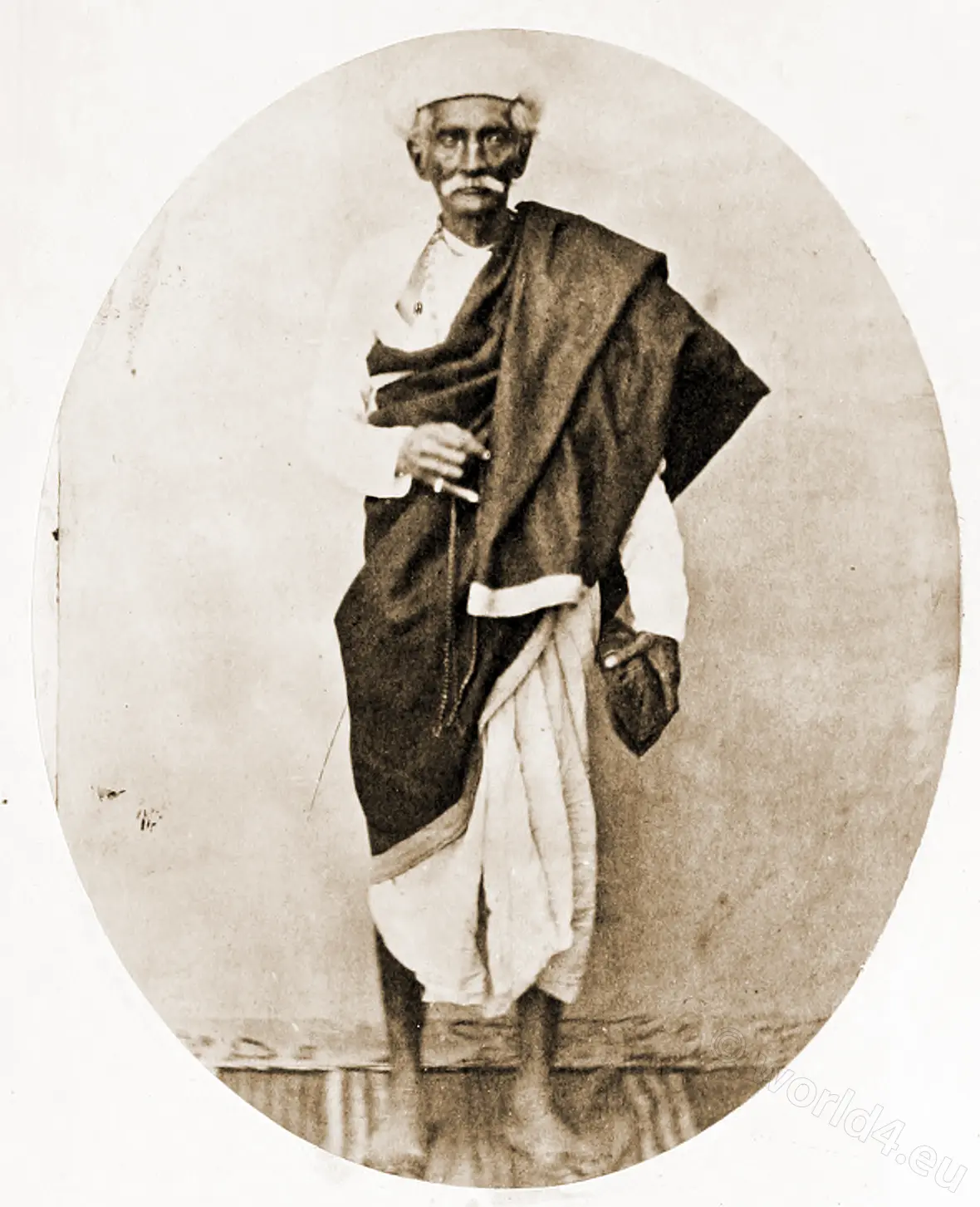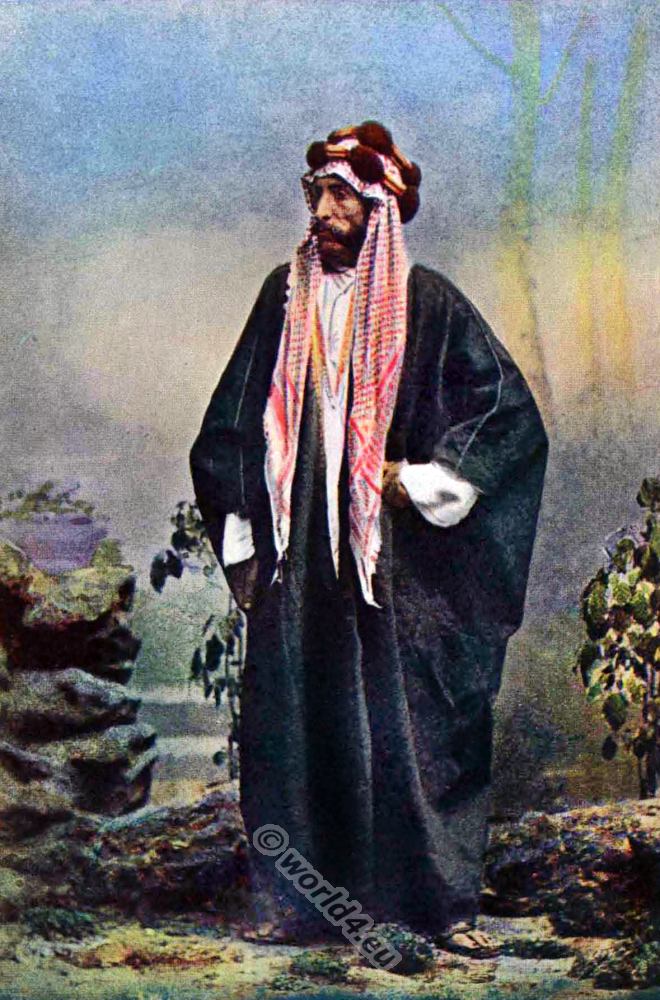
India. The Rajputs.
The illustrations we publish belong to the 17th century and are part of a series of portraits of the last rulers of the Kingdom of Telingana, of which Golkonda was the capital. Golkonda was destroyed by the Moguls. Since the Hindus, more than any other people, have preserved their old customs and traditions until the most recent times, one may assume that the costumes of the portrayed persons do not differ much from those of older times.
No. 1 – Djihan-Khan, wearing an unusual turban, quite unlike that worn by Muslims in that it comes over the forehead in a point. Made of heavy gold fabric, the shape of which is different from the Islamic one. The turban has a lace point above the forehead, is entwined with strings of pearls and decorated with emeralds, rubies and two feathers. At its top is a golden jewel, representing the sun, set with large rubies; this fastens a spray of fine feathers that bend down under the weight of two diamonds. The upper part of the body is dressed in a close-fitting jacket, whose wings are folded over each other at the front and which is held together around the body by a belt. This tight fit to the body is due to the abrupt change in temperature caused by the monsoon’s blowing.
The wide leg dress of silk reaches down to the ankles where it also closes tightly. The red velvet slipper has no heels because it was often discarded. Above the trousers the prince wears a skirt of transparent fabric. It is a type of muslin, whose delicacy always aroused the admiration of travellers. One tells that a piece of ten cubits could be placed in a tobacco tin or pulled through a ring, and another reports that such a fabric, which had been placed on the grass by an Englishman, was no longer seen because the grass was not covered by it.
The belt, from which four ends hang down, is decorated with precious stones. In addition, the sitter wears a sash with golden braids. With the exception of the thumb, all fingers are fitted with rings. A large pearl necklace with precious stones, two bracelets on the wrist and a third one on the upper arm complete the precious jewellery of the rajas *).
*) Raja or rajah (Sanskrit: राजा rājā, “ruler, prince, king”) is a title of rulers in India and parts of Southeast Asia; the female form is Rani (राणी rāṇī. Maharaja accordingly means “Great Ruler” or “Great Prince” or “Great King”.
The belt, from which four ends hang down, is decorated with precious stones. In addition, the portrayed person wears a sash with golden braids. With the exception of the thumb, all fingers are fitted with rings. A large pearl necklace with precious stones, two bracelets on the wrist and a third one on the upper arm complete the precious jewellery of the rajas.
If the feet were uncovered, you would also see rings on the toes. Also the vessel and the upper part of the red velvet scabbard of the long degene are decorated with precious stones. This weapon is called kunda. In the belt is a dagger, the khuttar, known only in Hindostan, a weapon with a triangular double-edged blade and a peculiarly shaped handle, the shape of which can be seen at No. 3. The handle of No. 1 is decorated with enamel.
No. 2. – Shah Soliman. Son of Shah Abbas, is equipped with a shield made of rhinoceros hide, which is decorated with six golden humps. The flower in his hand, whose fragrance he inhales, recalls the Indians’ preference for fragrant essences and perfumes.
No. 3 – Soliman Moasfdin is dressed all in white except for the turban. The fabric seems to be of the finest cashmere. He also does not wear jewellery.
(Based on original old Indian paintings from the library of Ambroise Firmin-Didot.)
Source: History of the costume in chronological development by Albert Charles Auguste Racinet. Edited by Adolf Rosenberg. Berlin 1888.
The Rajputs.
The Rajputs (राज्पुत ‘king’s sons’) were a warlike and knightly tribe from the caste of kshatriya, the second of the four Varna castes. In present-day India they are an ethnic group in the state of Rajasthan (formerly Rajputana). In the Middle Ages and in the beginning modern times the Rajputs made Rajasthan the stronghold of a princely India. Even today they still differ culturally from all other ethnic groups in the country.
First mentioned are the Rajputs in the Mahabharata, with modest territorial possessions near Delhi. After a historically dark period from the 4th to the 8th century AD, the names of the first kings appear as ancestors of 36 Rajput clans.
Half native, half descended from invading Scythians and Hephthalites from Central Asia, the Rajputs formed a genuine military aristocracy based on a feudal social order. The artistic taste of their princes also influenced the medieval temple architecture and sculpture.
The Rajputs were divided into clans with exogamous subgroups and were related to each other by complicated marriage networks. One of their clans, the Tomara, is said to have founded Delhi in 736. The four most famous Rajput clans of the early and high Middle Ages are the Pratihara, Chauhan, Solanki and Paramara.
At the end of the 8th century, the Pratihara dynasty ruled the northwest of India, claiming the ancient capital of Kannauj on the Ganges and also fighting against the Arabs in Sindh. The Pratihara state slowly perished at the end of the 10th century and the now independent Rajput clans appeared in history under this name.
With the raids and conquests by Mahmud of Ghazni († 1030) and later Muhammed of Ghur († 1206), an external threat emerged in addition to the internal disputes of the Rajput clans and other Indian rulers. With their caste-bound fighting style and code of honour, the Rajputs were subject to the massive equestrian attacks of the Islamic conquerors. Indian warfare was the task of certain castes (the Kshatriya) who recruited their followers. However, most of them were masses of untrained and barely equipped foot soldiers without internal cohesion, protected only by the (difficult to control) combat elephants, who could not withstand the (already militarily superior) cavalry of the conquerors.
Under Prince Prithviraj III Chauhan the united Rajputs armies faced the Ghurids at Tarain in the Delhi area in 1191/92. The war was finally lost. Prithviraj died and within a few years the Muslims conquered the entire North India. Nevertheless, all Islamic rulers in the Sultanate of Delhi and in the Mughal Empire had to defeat the Rajputs (e.g. Chittorgarh in Mewar 1303, 1568) if they wanted to rule in the country. These fights were always fought with great cruelty. If a fortress was about to fall, the wives and concubines of the Rajputs burned themselves before the men fell in the hopeless battle. However, after the defeat of the Rajputs’ Confederation under Sangram Singh (of Mewar, † 1528) against the Grand Mogul Babur († 1530) in the Battle of Khanua (March 1527), the Rajputs never again rose to a supra-regional power in India. In the second half of the 16th century Maharana Pratap was at the head of the 36 clan.
The great Rajput principalities were Mewar, Marwar and Amber (later Jaipur). A mythical family tree or a divine descent served to legitimize the claim to power. Of central importance were moon and sun. The human face in the corona of the sun was the coat of arms of Sisodia. In Udaipur and Mewar it can still be found today in many palaces and temples.
Akbar I ruled in the Mughal Empire from 1556 to 1605 and after his victory at Chittorgarh (1568) he made most of the Rajput clans his allies by initiating marriages with the Rajput princesses and raising their representatives to the highest state offices (ministers, generals, governors). In addition, his religious tolerance and the abolition of religious taxes provided him with an effective counterweight to the Muslim high nobility. When the strictly religious Muslim Aurangzeb (r. 1658-1707) abandoned this policy, he considerably accelerated the decline of his dynasty’s power. He tried to split up the principalities and appoint princes converted to Islam as princes, but this turned the Rajputs against him.
In the further course of the 18th century, the Rajputs lost political weight compared to the Maraths. They lost their pioneering role in the struggle against Islam. The elimination of marathic supremacy in British India led to the subordination of its princely states to British sovereignty (as protectorates). Their independence was maintained and only abolished with the formation of modern India (1956). Today the Rajputs no longer have the position they had in earlier centuries.
Related
Discover more from World4 Costume Culture History
Subscribe to get the latest posts sent to your email.

